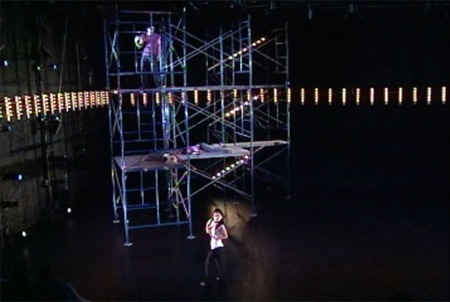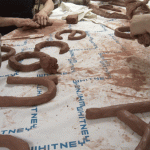The Business of Art: A Conversation with Sam Kim
Sam Kim, dumb dumb bunny (2007) in performance. Photo: Ryan McNamara.
Too few occasions crack the placid surface of habit. For me, one such fissure materialized last October during my brief turn as a dancer in Sam Kim’s dumb dumb bunny. I’ll never forget the piece’s penultimate moment when, planted atop a twenty-two-foot-high piece of scaffolding, dizzy with anticipation, I awaited the musical cue that would prompt me to rise.
Sam Kim took full advantage of the vertiginous scale of The Kitchen’s large black-box theater. The set was spare but dramatic: Hung halfway up the wall, vertical strips of lights lined the perimeter; the scaffolding hulked in the back corner, stage right, like some mythological beast. The movements were unusual: We posed and then were still, we trembled and stumbled, we canted slightly like reeds in the wind. The scaffolding became an alternative plane, the dancers scaling it to form a sort of Greek chorus, or, as one friend put it, an epiphenomena of the action below.
But perhaps the strangest thing about this experience, the tricky paradox that each of the twelve dancers in dumb dumb bunny had to negotiate, was this: We were working to achieve failure. Sam Kim’s piece was both an expression of the cruel vagaries of social arenas and a critique of virtuosity itself. As performers, she demanded that we commit to each movement, even when said movement was about embodying a fragile or inebriated state, filing into formation for a “Zombie Line” and working through scores with names such as “Drunk Geriatric” or “Statue Coming Down through the Ages.” It was choreography for monsters.
Sam Kim’s work explores the margins, shines light on the abject, and confronts us with the inanity of platitudes. She could be the rebellious choreographer heir to Julia Kristeva and Joan Didion. To George Romero and David Cronenberg. A dysfunctional family to be sure, but also a rich genealogy for artistic practice.
Sam Kim’s Self Surgery, a work-in-progress, will premiere June 20-22 at Brooklyn Arts Exchange (BAX). We discussed this and more during an interview in March at her Brooklyn home.
David Velasco: You’ve finished a full-length run of dumb dumb bunny [2007] at The Kitchen, and now you’re working on a new project, Self Surgery. What has this transition been like for you?
Sam Kim: It’s a bit like a death—and it’s a bit like being pregnant. It’s like being a dead pregnant woman. (laughs) That’s what my next piece is about. I began dumb dumb bunny in 2004 and its first full run was in 2007; that’s a long gestation period. When you live with something for that long, and then it comes to an end, it’s sad. But it left me with some seeds, some other tangents.
DV: What sort of seeds?
SK: When I choreographed an early iteration of dumb dumb bunny in 2006, I realized there were a lot of power struggles, lots of domination and oppression working in these concentric circles. But I think that role was constantly shifting among the twelve of us dancing in that piece.
DV: I recall Ryan McNamara [one of the performers] saying that you were the bully ofdumb dumb bunny—although you also got bullied yourself. I like this idea of bullyness being transient.
SK: And bullying as survival mechanism. In that landscape of scaffolding and lights—I knew that the tone had to be really bombastic. It was a cultural statement about people who are fearful of disappearing off this landscape. And the only thing they know to resort to in participating in this culture is being bombastic and posturing—literally posturing. That’s what we’re doing for the first fifteen minutes of the work.
DV: There was an element of posturing in Nobody Understands Me [2004] as well. I’ve always loved the stylization in your work, your attention to detail. It’s very polished, even when it’s raw.
SK: I don’t know where it comes from, but I’m very interested in stylization—taking apart style, using it, appropriating it to get at some sort of truth, which is part of the irony that’s at play for me. There are a lot of cultural signifiers in my work, too, things that are easy to recognize and go, “Oh, that—I know what that is. That’s horror movie stuff.” It’s always problematic, because it can stop people dead in their tracks. They become blind to how I’m subverting and playing with these signifiers. It’s upsetting on some level, but it’s also the premise that I’ve built for myself, so it’s interesting as a problem. I’m definitely attracted to horror—not so much the chainsaw blood and guts stuff, although that’s interesting sometimes, but say, Danny Boyle’s 28 Days Later, which makes a larger, humanistic statement about survival and the inherent cruelty of people. But it has to do with the body, too—these zombies, their altered bodies, things that aren’t functioning the way that they’re supposed to. That’s really rich for me to look at. David Cronenberg always does amazing things with the body. That’s the kind of horror I’m talking about.
DV: It seems that you’re more attracted to the elements of suspense and the darker themes in horror than you are the violence.
SK: My new project, Self Surgery, is totally about the horror and monstrosity of the body’s potential. And there’s reverence, too, for all the amazing things that it can do, as scary as those things can be.
In the most oblique way, Virginia Woolf has also served as a catalyst for me. Horror and Mrs. Dalloway. I’ve been reading The Waves very slowly, which is odd because I’m usually a fast reader. I don’t have any idea what’s going on. People just go to a lighthouse, and picnic, and party, and then they grow up. I don’t know a single thing that’s happened in the book; there’s no action to hang on to, and yet I know that the tactile sensation it’s left with me is so potent I’m compelled to slow down. Every page is this amazing, instructive gift of how to construct a really live, creative space.

Sam Kim
Press photograph for Self Surgery (2008)
(Photo: Ryan McNamara)
DV: How do you think that translates into your work?
SK: I’m hoping that some of that resonance, that particular syntax, will be remembered in a felt way. But I definitely don’t take notes, or try to manufacture something from that.
DV: During the development of dumb dumb bunny, you came to us with these scores, sets of instructions with these strangely apt titles, like “Statue Coming Down through the Ages.” How did that develop for you originally?
SK: I don’t know. I think it was something I was already doing with my body. I knew that I had to come up with a sort of terminology, some necessary shorthand so that the dancers could understand what I was saying. That’s an unwieldy name for a score, but I think it does capture the idea of some kind of permanence existing through time, which endures and is kind of alive, but is also restricted. That was the tone and the quality I was trying to gather into this one task.
DV: I recall learning a movement you called “Gnarled Trees,” and one way you described it was that we were supposed to think of Merce Cunningham, but not Cunningham—
SK: —not in his prime…
DV: —but him currently, sort of palsied, sort of…gnarled.
SK: I saw that footage the other day, and it’s really incredible. You don’t look like people to me, you look like something other that’s got problems.
DV: I like that with the title Self Surgery you evoke both destroying one’s self and fixing one’s self.
SK: Right. A kind of paradox. That the role and function of the person who should be performing on you, by default, is just not there, so you’re left to your own devices.
DV: Your musical choices have always set your work apart. How do you decide on your choreographic scores?
SK: I think my use of pop music is my attempt to bring things down a bit—I’m trying to cut into a certain preciousness that is really dangerous with dance. I’m resisting making work that’s really symphonic. I also think my use of pop shows that my work exists in this moment. With pop, obviously, each track is about three-and-a-half minutes, which is oppressive in a way. People always notice the music so much, which I always claim is problematic; they definitely want to talk about my choices. With dance in general it’s an issue because people make musical visualizations: Everything is on a beat, there’s a gesture per count. Which is ridiculous. I’m trying to shift the relationship between dance and music.
DV: I remember how jarring it was to see you ignoring the beat in Nobody Understands Me. Then near the end, when “Personal Jesus” came on, there was this moment when everything rose with the music. It was incredible to witness after watching you disregard the conventional rhythm…And then everything came together. With dumb dumb bunny, there was that moment of disco near the end…
SK: A fragment of disco. A disco fragment. There’s the music within the structure of a dance piece that has its own logic, its own syntax, which I’m going to loosely call “music.” And then you have literal music going on. I’m into coming up with compositions where I can use that resistance, that discomfort.
DV: As a dancer, we’d learn phrases, sometimes to certain kinds of music, and then, once we were onstage, sometimes the music could be entirely different. It was unpredictable.

Sam Kim
Press photograph for dumb dumb bunny (2007)
(Left to right: Miriam Wolf, Sam Kim, Liz Santoro, David Velasco)
(Photo: Ryan McNamara)
SK: I think that shows how I’m not invested in that relationship. I’m not going to let music be the dominant, oppressive organizing principle in making a dance. It also keeps everybody on their toes—you cannot rely on it to carry you through a performance. It’s a way of sidestepping apathy.
DV: It reminds me of Merce Cunningham’s Points in Space. John Cage arranged the music separate from the choreography, and the dancers didn’t hear it until the performance.
SK: Definitely. Merce was one of the first to liberate us from the tyranny of music.
DV: Do you have any larger goals as a choreographer? Is there something you’re striving for right now?
SK: I think it would be amazing to have an audience where I know them and they know me, and it’s about seeing my work unfold over time. When I see dance and it’s speaking to me and there’s something resonant and fundamental about it, there’s nothing better. That’s really why I’m in this form, because when dance does work, it’s transcendent.
Sam Kim is a choreographer based in Brooklyn. Her performance works includeValentine (2002), Placid Baby (2003), Nobody Understands Me (2004), AVATAR(2006), Cult (2007), and, most recently, dumb dumb bunny (2007), which had its full debut at The Kitchen last October. A member of the Board at Dance Theater Workshop, she has been the recipient of awards from, among others, The Rockefeller Foundation/Multi-Arts Production (MAP) Fund, the Bossak/Heilbron Charitable Foundation, Movement Research, the Brooklyn Arts Exchange, and the 92nd Street Y Harkness Dance Center. She is currently an Artist-in-Residence at the Brooklyn Arts Exchange.
David Velasco is a critic and Managing Editor of Artforum.com. Recently, he interviewed Jack Pierson for 032c, Paul P. for MUSEO, and Paul Mpagi Sepuya for his artist book Beloved Object and Amorous Subject. He has performed in several dance productions, including Kimberly Brandt’s No Fail at P.S. 122 (2003) and at Williamsburg Art NeXus (2004), Anthony Thomas with Brandt and Ryan McNamara at Dance Theater Workshop (2006), and Sam Kim’s dumb dumb bunny at The Kitchen (2007).





